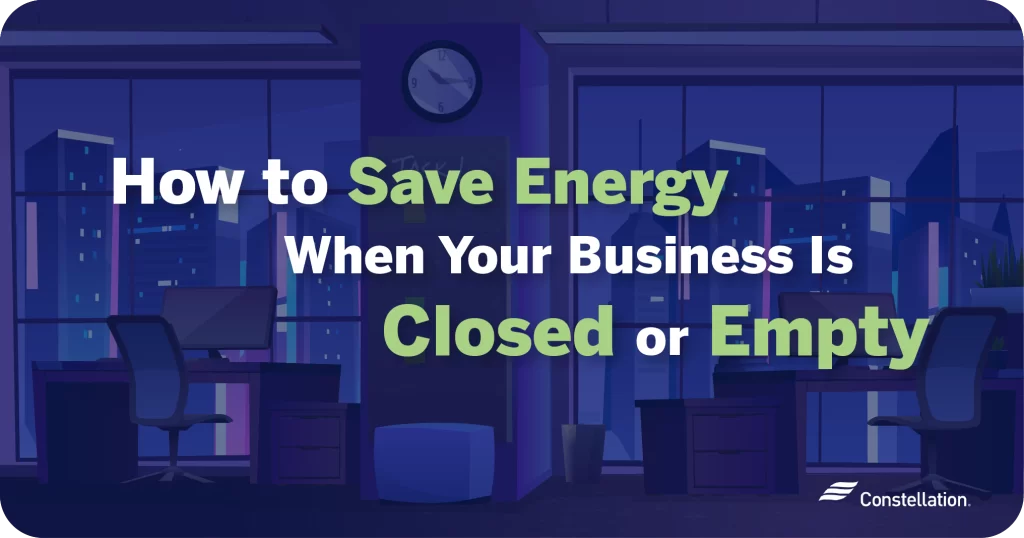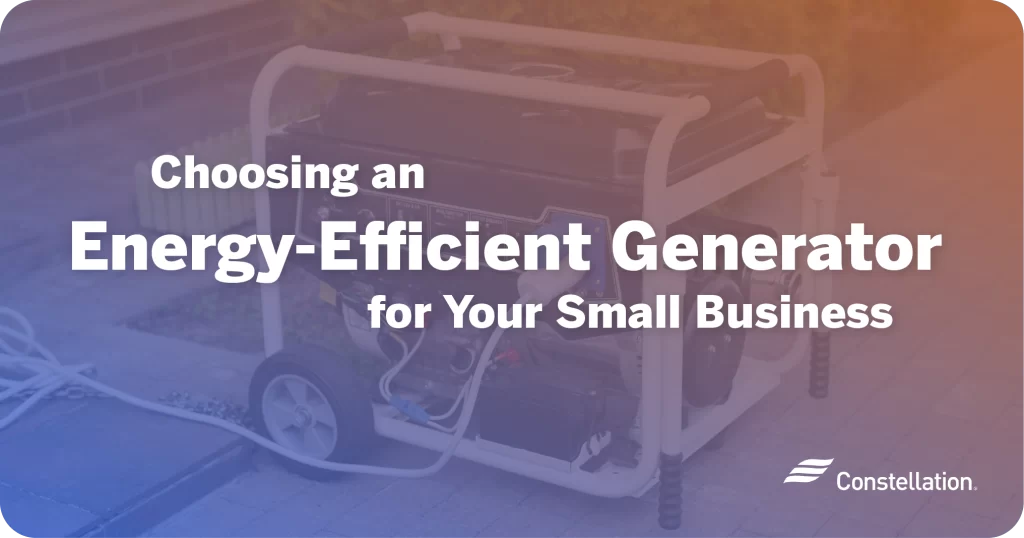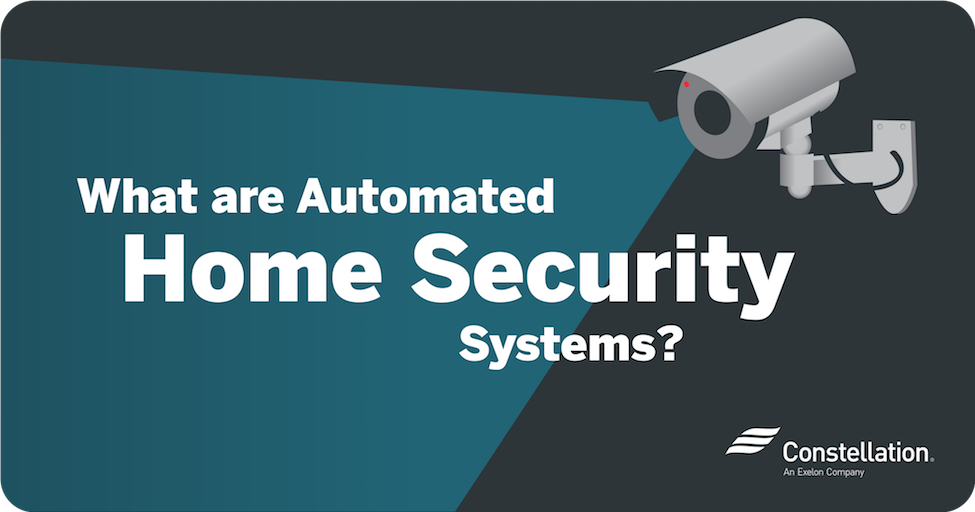
- Category:
Home Energy Savings -
Last updated:
September 4, 2018
What Are Automated Home Security Systems?
Connected homes are the wave of the future, and automated home security systems are no exception. In terms of home monitoring or deterring crime, combining home automation and security is the way to go: you can program, monitor and control your security system remotely or by using an in-home dashboard. These systems, such as Constellation’s home security hub Constellation Connect, connect with equipment like high-decibel alarms, certain types of security cameras, home automation locks (smart locks), motion sensors, control panels, and apps. If you want to invest in a home automation security system, you first need to decide how your system will be installed.
DIY Home Security Systems vs. Professional Installation
When you get a home security system, you must install it—whether you do it yourself or have someone set it up for you. There are advantages to both DIY (Do-It-Yourself) home security systems and professionally-installed systems. Here’s a quick overview so you can make an informed decision.
Advantages of DIY Home Security Systems
- You could save money. By choosing a DIY home security system, and installing your security system’s equipment and control panel yourself, you could drastically cut down the initial cost of your automated home security system.
- You have more control. With DIY, you can customize and adjust your system as needed. Add sensors or cameras as your needs change. You may also be able to integrate DIY home security equipment with your existing smart home products.
- You can do things on your own time. No appointments needed, and no need to be home during normal business hours. With DIY, you can install your system on your schedule and at your pace, be it at sunrise, sunset or anytime in between—seven days a week.
Advantages of Professional Installation
- Let someone else do the work. Someone else performs the installation of your home automation security system, so no need to read directions.
- You benefit from expertise. A professional can cover all the bases and walk you through the operation of your new home automation security system.
- You could get a discount. Some security companies might include cost-saving incentives with an installation.

Equipment Needed to Set Up an Automated Security System
Home automation security requires a few additions to standard items—such as the control panel, alarm and yard signs—but these will transform how you manage your security system and might even introduce energy savings in your home. Most devices offer the capability to remotely manage your home security system (e.g., a mobile application and a light-control module). Others include the following:
- Home security cameras
- Video-surveillance doorbells
- Home automation locks (smart locks)
- Security sensors (entry-detection sensors such as motion sensors and motion-sensing lights)
Now, you may be wondering, how do I choose from all the types of security cameras? Or, how do smart locks work? Keep reading to find out more!
Home Security Cameras
A security camera is one of the best ways to both identify and catch burglars, especially because it’s more likely that a burglary will take place when no one is home. There are several types of security cameras to choose from, and they all have various features and benefits.
Benefits of Home Security Cameras
There are many benefits of home security cameras. And if you have a security camera in your home automation security system, the advantages increase.
- They deter crime. If criminals spot a camera, they just might change their minds about breaking in.
- You can remotely access from anywhere. Wi-Fi-enabled security cameras can alert you via your smart device no matter where you are.
- They give you more connectivity. Security cameras can interface with your hub and help inform you when to use your other automated devices like smart thermostats or light switches.
- You can have peace of mind. Even if it’s only to check up on pets while you’re away, a security camera integrated into your smart home will keep anxiety at bay.
Are Home Security Camera Systems Energy Efficient?
You can maximize the benefits of home security cameras by making them part of your total home security automation plan, which can help you save on energy. For instance, you can control your thermostat or turn lights off from your smartphone. If you notice that the sun is shining brightly into your living room, text your kids, and have them shut the curtains!
Pro Tip: If you’re looking to beef up your home energy savings, start by practicing daily energy conservation!
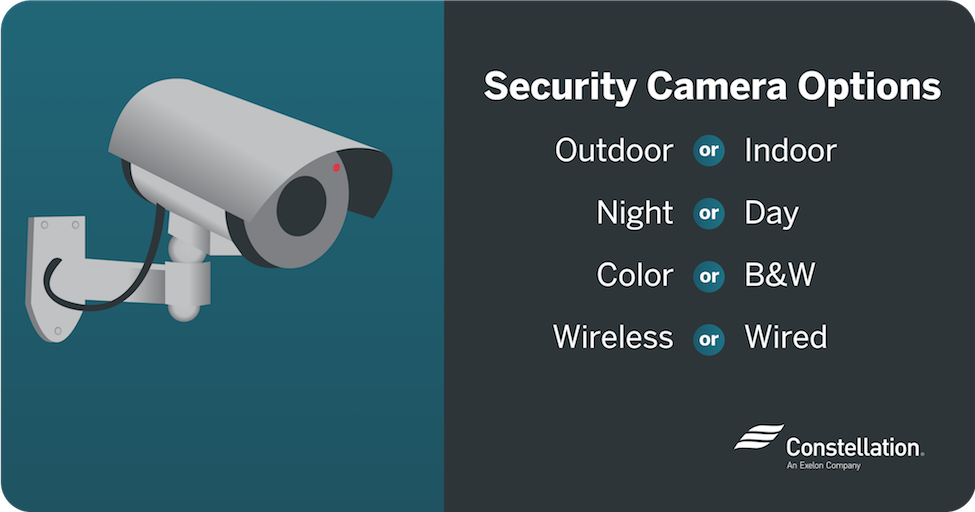
How to Choose the Best Security Camera System
When choosing among the various types of security cameras, we’ve compiled some tips for what to look for when purchasing one to add to your automated home security system.
- Wi-Fi capability. A Wi-Fi-connected camera sends notifications to your smart device and allows you to keep an eye on what’s happening at home without having to invest in a fully automated home security system (a great choice if you live in a small apartment).
- Outdoor or indoor. Indoor and outdoor security cameras differ based on the types of external factors they can withstand. They come in similar styles and have similar features, but outdoor cameras must be able to withstand all types of weather and light conditions.
- Day/night use. Most types of security cameras can observe and record what’s happening during the day, but the distance from which your camera can record images in low to no light is directly related to effectiveness, because criminal activity often happens at night. Some cameras boast night vision up to 30 feet and others to 100, so be sure to check the specifications.
- Video storage. Your footage likely won’t be saved on the camera itself. Most types of security cameras store information on the cloud (software used through network connection), and some models have SD card slots so that you can physically pull the video when you want to review it.
- Color or black-and-white video. Color video gives you a better chance to identify a perpetrator based on something like clothing; however, color security cameras don’t perform as well in low-lighting conditions. Black-and-white security cameras can perform in even the dimmest of conditions and are often cheaper.
- Recording modes. Continuous (24-hour) recording catches everything, even if it’s not helpful. Motion-detecting recording doesn’t capture unnecessary events, which saves bandwidth and storage. Scheduled recording also saves bandwidth as you can program your camera to specifically record only during certain times.
- Video resolution. The higher the resolution, the more visual information a security camera can capture, resulting in better clarity of the footage, especially when zooming in.
- Wires or wireless. Some types of security cameras must still be connected to a power source and require video cables to transmit footage to devices such as a computer or television. But a wireless security camera transmits the video (and audio, if included) over the Internet to a receiver that connects to your device.
- Motion detecting. Most Wi-Fi-connected cameras have built-in motion- and sound-detecting sensors and will alert you when those sensors are triggered.
- Field of vision. Field of vision—how wide an angle the camera can record—is important because it affects how many cameras you need and where to place them. Some newer types of security cameras have a 360-degree field of vision.
Extra Feature: Video-Surveillance Doorbells
A video surveillance doorbell offers a “video peephole” that will help you cut down on risks associated with opening the door for strangers. If you install a smart doorbell with live video streaming and home automation compatibility, it will add another layer to your fully automated home security system.
Constellation Connect protects your home.
And your peace of mind.
Automated Smart Locks
Smart locks for home automation are a convenient addition to your automated home security system. Their smart technology can help streamline your daily home access and prevent lockouts.
How Do Smart Locks Work?
Smart locks, or home automation locks, are electromechanical locks that you can lock and unlock remotely. They monitor who goes in and out of your house and can grant or deny access remotely via a mobile app. A smart lock has no physical key—your smartphone or a key fob (a piece of hardware that wirelessly unlocks the door) is configured to perform the necessary wireless authentication to automatically unlock your door. You can send a virtual key to a receiving smartphone via e-mail or SMS. The recipient will then be able to unlock your smart lock during the time you specify. You are in total control of who can enter your house—even when you’re not there!
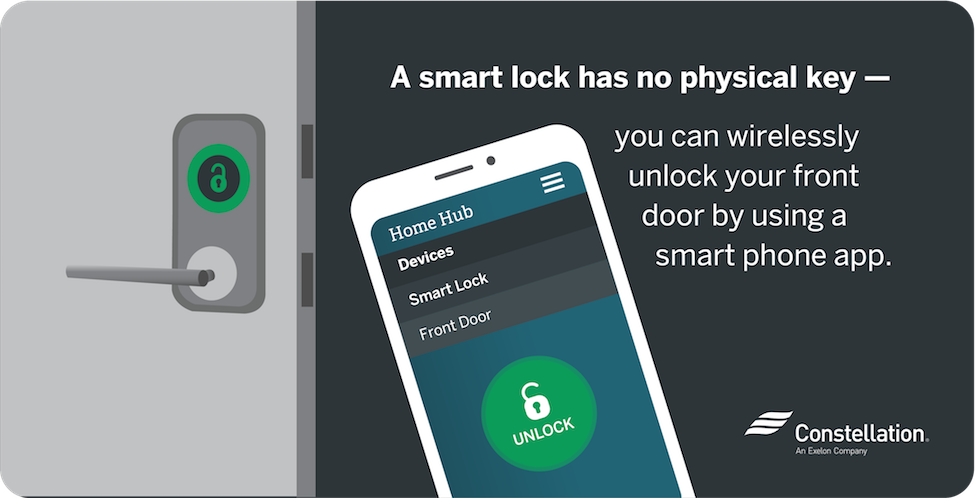
Benefits of Smart Locks
The benefits of smart locks for home automation are focused on convenience, security and connectivity. Here are the three biggest benefits of installing smart locks for your home:
- “There is an app for that”. You can use a single smartphone app to control the locking and unlocking of doors and receive mobile alerts when something is amiss. Lost your keys? No biggie. You won’t need a locksmith to help you get into your home.
- Secure your entrances. You can manage and track who enters your home and from which entrance by programming your smart locks with unique access codes.
- Connection with other smart devices. By integrating smart locks into your security system, you can increase your total home security automation. To maximize the benefits of smart locks for home automation, consider programming them with your security camera and security alarms.
Pro Tip: To learn about other smart devices and the time-, money- and energy-saving benefits of smart homes in general, check out “What is a Smart Home?“.
Home Security Motion Sensors
A motion sensor, or motion detector, is a critical part of a home security system. It’s the primary piece of equipment that detects an intruder.
How Do Motion Sensors Work?
A motion sensor uses various types of technology to detect movement in an area. If movement trips a sensor, your security system’s control panel receives a signal, which in turn alerts you to a potential threat in your home. In addition, motion-sensing lights are a great addition to home security, as they detect movement and then signal a light to turn on, deterring would-be criminals. Remember that security sensors are different from light-switch sensors, but you can learn more about the home energy savings of indoor light switch motion sensors here.

Benefits of Security Sensors
From motion detectors to motion-sensing lights, these security measures have a variety of benefits that make them excellent crime deterrents and great additions to your automated home security system.
- Security is heightened. The core purpose of a security sensor—and its biggest benefit—is securing your home against burglars. If your system is breached without alerting you to a door or window being opened, your security sensors will detect an intruder and sound the alarm. This gives you time to call for assistance.
- False alarms are a thing of the past. Security sensors are so advanced that you don’t need to worry about pets setting them off.
Security sensors easily disabled. You can easily disable a security sensor if you feel the urge to grab a midnight snack. - They catch almost everything. Security sensors can cover nearly the entire area of a room.
- Having sensors reduce overall crime. Motion-sensing lights in particular deter crime: they leave would-be burglars with no place to hide, and they give you more time to investigate or call the police.
Tips for Buying an Automated Home Security System
If you’re ready to invest in home security automation, you’ll want to research available companies, be aware of up-front and monthly costs, and prepare to protect your privacy. Below are some tips for shopping for equipment and home automation security system providers.
- Don’t go with the cheapest option. There’s a reason that certain home security companies rank higher than others; look for quality, not just low-cost! Remember too that you may save money—perhaps even 20 percent—on your insurance by buying a home automation security system.
- Pay attention to up-front cost vs. subscription costs. Many professionally installed home security systems require you to pay an activation fee and sign up for a one- to three-year contract. DIY home security systems usually do not require activation fees or contracts. After the initial setup, both professionally installed and DIY security systems charge for monthly monitoring.
- Choose a complex password. Never keep a factory-setting password, and be sure to only share it with only a select few people. Choose a complex password that is not easy to hack, and change it often.
When you research the ins and outs of home security and automation, you’ll find that it’s all about connectivity. And your connected home doesn’t end with security: discover how voice-command assistants can help you maximize your energy-efficient smart home in our comparison of Amazon Echo vs. Google Home, and learn more about home automation here.
